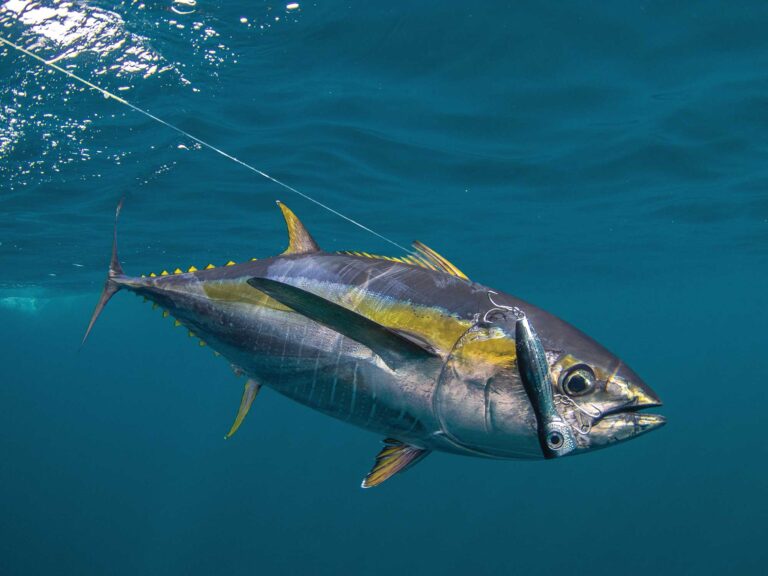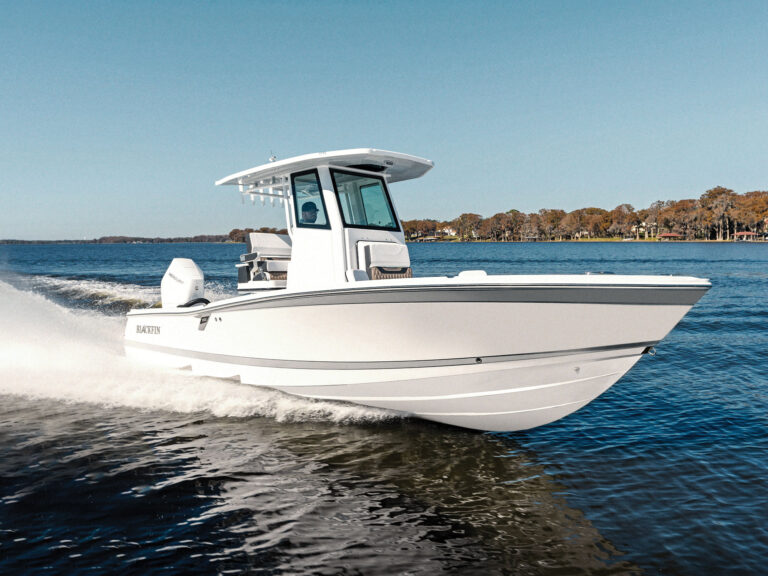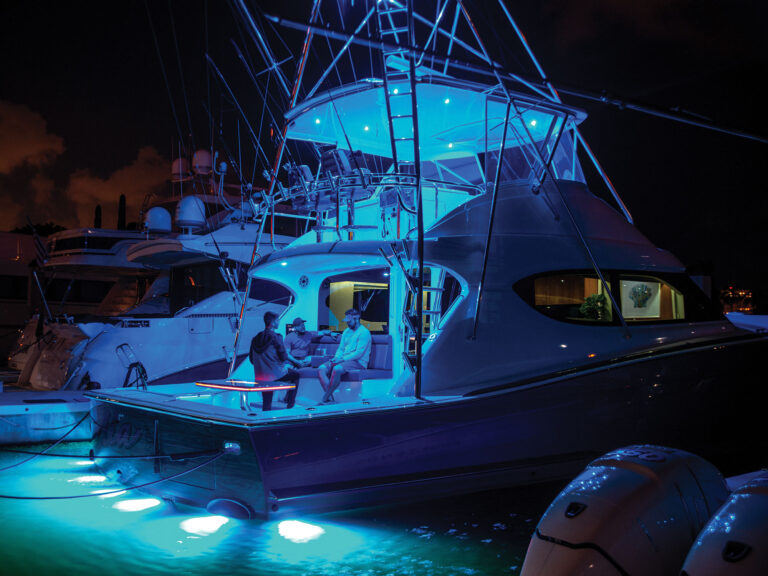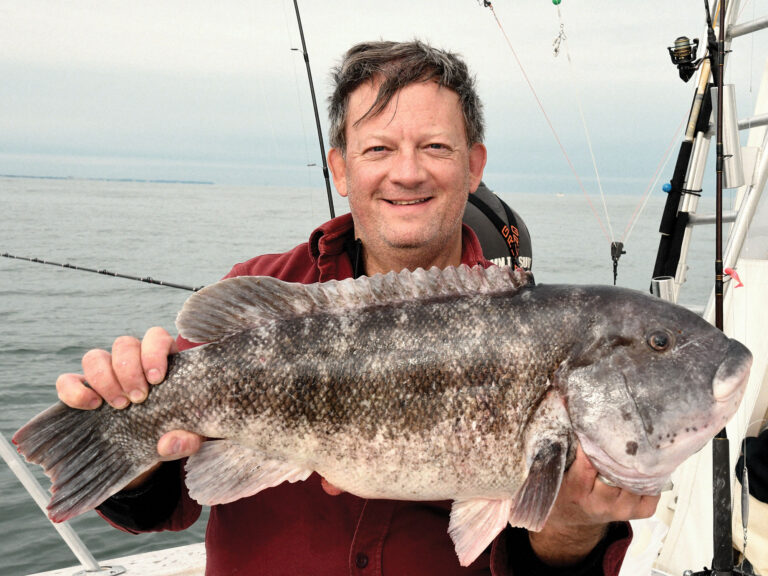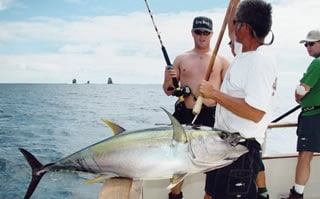
| Using rigs tied with fluorocarbon leaders and 5/0 circle hooks can help fool shy tuna around structure. |
Whether it’s using “stealth rigs” and light tackle to fool shy tuna or taking a page from the notebook of their Asian counerparts, West Coast long-rangers always keep an open mind. And just when you thought that everything under the sun had been tried in the quest for yellowfin tuna and wahoo, another innovative idea comes along. Here are just a few clever ways that today’s long-range anglers and crews are coaxing more bites and landing more fish on their trips to distant hot spots such as Alijos Rocks and Cleofas Bank.
1: Stealth Pays
So-called “stealth rigs” made of fluorocarbon leader and 5/0 ringed circle hooks are a great way to fool big yellowfins, especially at spots such as Alijos Rocks, where the boat has to be anchored near fish-holding underwater structure. “Alijos is the perfect place for stealth rigs,” says Royal Star skipper Randy Toussaint. “Just like at Guadalupe Island, the tuna often feed way back from the boat. The bite over structure isn’t the same as it would be on a wide-open drift bite. Whatever tricks you can think of to draw a strike are good.”
2: Stay In Touch
Fishing from an anchored boat also makes it tough to keep track of your mackerel or sardine when it swims 100 yards or more from the boat. This is definitely not the time to use a belly-hooked bait. Such a bait may get bit on the way out as it swims deep and down-current, but when it gets to the end of the line out there in the bite zone, it will be forced to slow down or stop.
“It’s just going to sit there and twist in the breeze,” says Toussaint. “If you’re going to fish a bait on a long soak, it’s better to nose-hook it. That way, you may still get bit as you bring it in.”
Pay attention as you’re reeling in the bait, especially if you can still feel it moving. If you feel the bait getting nervous, it could mean that it’s being eyeballed by a predator and about to get bit. If it’s not moving at all, it isn’t doing much for you. Always use your fingers and the rod tip to monitor the line as you’re reeling in or you could accidentally wind in other anglers’ baits.
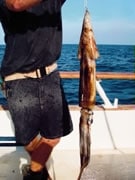
Big tuna love big squid, whether chunked, drifted whole or fished on a kite.|
3: Go Fly a Squid
Alijos yellowfins sometimes go bonkers for flying fish. When this happens, it’s time to fish a dead flying fish from a kite. On some trips, every “flyer” that goes out on the kite gets eaten, usually before it can reach “the zone.” And when flying fish are tough to come by as bait, hefty squid can be subsituted.
Fishing big squid requires a little extra rigging. “We use two 9/0 J-hooks on the kite rig, one in the mantle and one in the head,” Toussaint explains. “That’s because tuna bite the heads off, even with the hook there. I use the same rig for fly-lining big squid.
“By the way, squid chunks are effective for this type of fishing, too, but you’ve got to have enough to use as both chunks and bait. We get lots of tuna on squid chunks. Like the kite tuna, a lot of them are bigger fish.”
4: Ride the Rail
Sometimes the rail can be your best friend when it comes to landing a fish. I recall grinding on a 100-pound fish at Cleofas Bank aboard the Qualifier 105. I was panting under the hot sun when Accurate Fishing Reels owner Jack Nilsen walked up.
“Put the rod on the rail,” he advised.
“The rail’s pretty wide here,” I replied, “and there’s a lot of sideways torque when I put it down.”
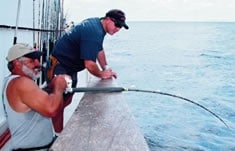
Don’t be afraid to use the rail to put the hurt on a big fish, as this angler is doing.|
“Put it on the rail,” said Nilsen, “and hold your left hand on top of the reel to steady it.”
Later, Nilson explained that the technique is very effective on an anchored boat that can’t be moved to help the angler. He learned from Jack Webster – a well-known sport and commercial tuna skipper – that the best place to fight a tuna is two-thirds to three-quarters of the way toward the bow, where the rail starts to widen. “Here, a circling tuna can’t rub the line on the chine or anchor line,” Nilson explained. “If the deckhand has you there, he doesn’t want you to move again, so just pry the fish up where you are. When the fish runs, give him line. When he comes in during the circle, wind in low gear. Your crewman will tell you when to lift; he can see the fish better than you. It’s a timing thing. At the end, take the rod off the rail and put the butt in your gut, and he’s yours.”
Nilson employed the technique he described to deck several 100-pounders on our trip. Using the rail to fight the fish will disqualify you for an IGFA world record, but an increasing majority of long-rangers are doing it.
5: A Leg Up
Skipper Steve Loomis of the Royal Polaris agrees that the rail can be a useful weapon for fighting a big tuna. “(Laying the rod on the rail) is definitely an easier way to pull on fish than standing up with a harness. It’s easier on your back and arms. On the Royal Polaris, we suggest trying this technique and seeing how it works for you. A lot of the time, you have to get down on one knee. Without the gimbal to steady the rod, you can put your hand over the top of the reel.
“On big yellowtail, try putting one leg over the rail and the rod butt under your armpit, then lay the rod across your thigh. Put your left hand on top of the reel and wind with your right.
“On our tuna trips, we see more people doing this all the time. Who’s doing it? Our regulars, the guys who fish hard, and it’s catching on. With Spectra backing and this technique, you can get away from 80-wide reels and really heavy gear. In fact, some of the guys are getting cows (tuna over 200 pounds) on Penn 20 reels now.”
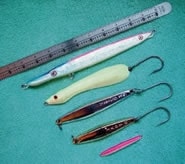
These jigs will take both wahoo and tuna, whether jigged deep or ripped across the surface.|
6: Dance a New Jig
On a recent trip to Cleofas Bank, a group of anglers from Taiwan and Thailand out-fished their California counterparts by using an exaggerated jigging technique and long, slender, heavy jigs. These jigs weighed up to a pound or more, and were fished with two circle hooks tied to a short length of Spectra attached to the top eye of the jig. The Asian anglers used Spectra line and short fluorocarbon leaders, and they fished the jig on the rise, with a violent snapping action of the rod tip.
“Back home, we fish tuna in deeper water,” explained Alvin Lim, who runs a Singapore tackle store. “We often have to fish tuna at 600 feet. Using these jigs and Spectra line lets us get down there.”
Lim’s method of fishing can be exhausting. It involves cranking the jig as fast as you can, stopping every ten or 20 cranks, then heaving on the rod as you begin winding again. Lim and crew keep the butt of the rod locked in a belt for leverage, unlike California anglers, who keep the rod under their armpit. Their success proved that you can’t crank a jig too fast for tuna.
7: Bombs Vs. Jigs
Do wahoo prefer bombs or jigs? Inquiring long-rangers would love to know. “Although they’ll bite both casting jigs and bombs, I believe you get a better hook-up ratio on the bombs,” says Loomis. “I see more wahoo come aboard with bombs when the whole rig, including the jig and the hook, is inside the fish’s mouth.
“With regular jigs, I see more fish with the hook stuck in the outside of the fish’s mouth. That may happen when the ‘hoo grabs the jig sideways (and the hook is pulled into the side of its jaw). I think you should keep winding on the strike, right through that first ten- or 20-second run.”
8: Don’t Quit on skins!
Catching wahoo on metal jigs takes perseverance – and a strong casting arm. “You’ve got to keep throwing the jig if you want to catch wahoo, maybe for an hour or more,” advises Loomis. “The fish may swim closer to the boat at any time while we’re throwing live chum and chunks over the side. Sometimes the ‘skins’ are close to the boat; other times they may lay off 100 yards or more, so you’ve got to keep casting or you’ll miss ’em.
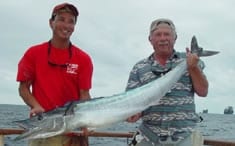
Catching wahoo from a long-range boat takes perseverance – and ultra-sharp hooks.|
9: Wahoo Whackers
Long-range wahoo techniques and lures have taken some strange twists over the years. “I’ve been fishing wahoo since we first started making long-range trips,” recalls long-range legend Bill Poole. “Back then, we used to take three albacore feather jigs, and string ’em together, and that made a pretty good wahoo jig for trolling. Now the best trolling jigs are the big wobblers like the Marauder. Most jigs work, but the fish like the wobblers a lot better. They like dark colors, too. They say fish can’t see color, but I think that’s wrong. The orange-and-black and purple-and-black Marauders seem to get the most fish. They sure work better than silver lures. On the other hand, bombs with a silver head and tinsel sure work well. They sink fast, but they don’t wiggle.
10: Advice for Ironmen
|||| |—|—|—| |### Catch Big- Game Fishing Action on TV| If you’re a big-game fanatic, be sure to catch “Standup Fishing with Bill Roecker,” a new TV show that airs on The Outdoor Channel at 11:30 a.m. Tuesdays and 8:00 a.m. Thursdays. The new program will introduce viewers to the excitement and fun of fishing from Alaska to Baja, and will cover all aspects of fishing, from finding the fish and rigging up to releasing or cooking the catch. For more information, visit www.fishingvideos.com. The website is also where you can purchase Roecker’s series of exciting fishing videos, including “Cleofas Adventure” and “Alijos Adventure.” They are available on VHS tape and DVD formats. – Ed.
“When you’re jig-casting for wahoo, use 40- or 50-pound line,” says Tim Ekstrom co-owner of the Royal Star. “I prefer 50-pound, because it doesn’t stretch as much. Also, make sure your hooks are sharp. It doesn’t matter if you use a fancy sharpener or a hand file, but sharp’s an absolute for wahoo.
“You don’t need a long cast or a long rod. A seven-footer is best, with a medium or heavy action, so it doesn’t feel spongy. Something like a Calstar 700H is great. You want a nice, firm action, because you don’t want to risk losing tension. We’ve all lost wahoo by having the hook fall out. Plant that hook!
“The most important thing you can do is take a look at what the other guys are using. If you see everybody fishing a bomb, go for a jig. Try something different, especially when it’s slow but you know fish are around. You see it happen all the time: some guy will try something different and hook up right away.”





